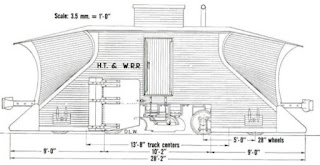Being in the north east we can sometimes have harsh winters and along with these winters comes snow. Now if its light dusting the snow is "silly soft stuff" and the steam engine can brush it aside. But where we get hit with a classic Nor'Easter and get feet of snow, its time to run the snow plow.
Now this would be considered a normal train in the north east and other areas with heavy snowfall. However like most thing along the Valley, there is something that make the Valleys different from other railroads. In this case its the snow plow itself.
Known officially as the Hoot, Toot & Whistle double blade snow plow, or HT&W plow for short, is a true one of a kind model. Originally designed for narrow gauge by the chief mechanical officer of a unknown logging railroad. It was sold before being completed as is to the Hoosac Tunnel and Wilmington Railroad who overhauled what was started to create a fully functional snow plow. At first the plow blades where made completely of wood with only a small strip of metal on the tips of the blade. Seen here in this sketch featured in Model Railroader Magazine.( not to scale)
As you can see from the drawing the has a blade on each end bu there is a true "front" to the plow. In this particular drawing the "front" is to the left; indicated by the direction of what I have been calling its wings. The "wings" extend out to direct snow further away from the track. So if there is a designated front to the plow why design the second blade at the rear? To answer that we need to look at the original right of way for the HT&W.
The HT&W was created in 1892 as a Narrow Gauge line serving the logging industry around the boarder of MA and VT. It was later converted to Standard Gauge in 1913 after damage due to flooding of the Deerfield River. The line was a point to point with no place to turn equipment around on the north end. This fact was the main reason for the snow plow to be double sided. If the plow was needed it would be pushed by a locomotive to north to the end of the line. The hope being that most if not all of the heavy snow would be shifted away from the track so that the side "wings" would not be needed for the southbound run. At its northern point the locomotive would run around the plow and arrange itself in between the plow and loaded cars. It would them head back south.
Over the years the plow was rebuild and improved. Still made from a wooden base, but the blades were now completely covered in metal sheets. Seen here in the 1960s.
The HT&W struggled on for a few more years past this point but eventually went belly up in 1971. Its at this point the plow moved to its current home in the lower CT Valley. Im not sure how exactly It got there; but I do know that in the 90s it had another repair/rebuild lead by one of the members of the Friend of the Valley Railroad. That about wraps things up for the actual plow. Every winter the plow is preped and positioned in the yard ready to be collected by 0901 ready to clear the tracks once again.
Now that you all have a brief summery of the plows life we can talk about creating a HO scale version of it.



No comments:
Post a Comment